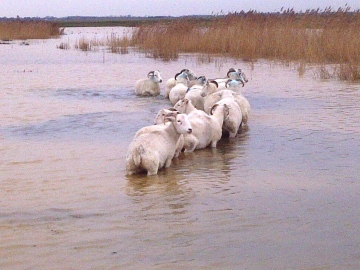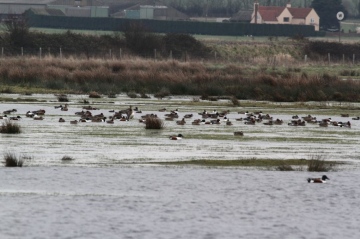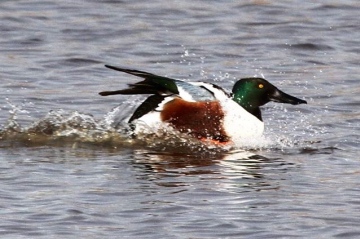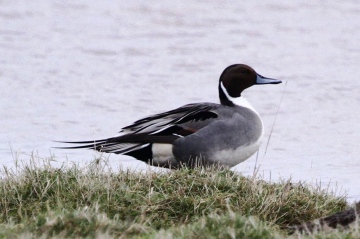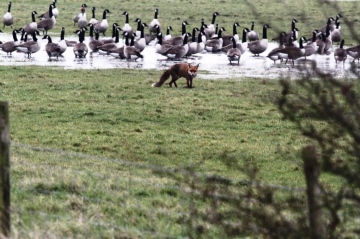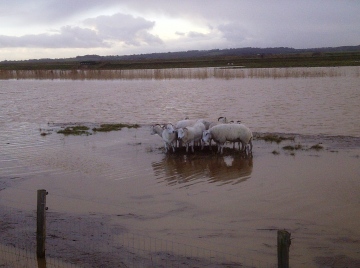
It is a little known fact that sheep do not like to get their feet wet. They can swim perfectly well but when stranded on small islands of higher ground amid floodwater – like the Wiltshire Longhorns pictured here at Blue House Farm EWT Reserve recently – they prefer to wait patiently for the water to subside rather than attempt to brave the flood. This is an admirable trait compared with the behaviour of many motorists. A much maligned animal is the sheep. The contempt we have for them springs from their flocking behaviour and the instinctive desire of the more submissive animals to follow the dominant members of the group. In Turkey recently the leader of a flock attempted to leap a fifteen foot wide ravine - and all 399 of his followers followed suit, with unfortunate results. Following a Great Leader to perdition is unknown among us humans of course, hence the contempt…………
If you want to exploit an animal without worrying too much about it, it probably helps if you look on it as being stupid but recent research has shown them to be anything but. In Yorkshire, sheep have been observed lying on their sides and rolling over and over in order to cross three metre wide ‘hoof-proof’ cattle grids. The lure in this instance was the cabbages and lettuce in village gardens as sheep, given the choice, prefer a varied diet rather than boring old grass. Research in Australia has revealed that sick sheep may actually be able to detect what nutrients they are deficient in and actively seek out plants that make them feel better, having developed a knowledge of which species are beneficial and which toxic. Perhaps that is what those Yorkshire sheep were up to! Researchers have also found that a sheep can recognize the faces of over fifty other sheep and familiar human faces as well; indeed, it is thought that they may be as good at picking out faces in a crowd as we are. They also form family and social friendships within a flock and ewes have definite opinions about what makes a ram’s face attractive!
As for Icelandic sheep, they are a class apart, as I can vouch for myself. I was once savagely assaulted by an Icelandic ewe when I got between her and her lamb. The incident happened close to Lake Myvatn, in the north of the country. I had stopped on the road to watch a Gyr Falcon and was standing astride my bike when the ewe in question came charging up the gravel embankment and head butted me with such force that I was catapaulted down the other side, landing in a grazed and bloodied heap at the bottom. The humiliation of it – done over by a sheep! But now what do I find? There is a strain of sheep in Iceland known as Leadership. Leadership sheep are highly intelligent and have an exceptional ability to sense danger. Apparently there are numerous stories in Iceland of Leadership sheep saving many lives during the autumn roundups when blizzards endangered shepherds and sheep alike. There you are. I don’t feel so bad about it now. In fact it almost feels like an honour – to have been beaten up by a Leadership sheep. Mind you, having read Rider Haggard’s adaptation of the Icelandic sagas as a youth it should not surprise me that Eric Blood Axe and his compatriots’ sheep are chips off the same block! (Thank you www.followyourdreamfarm.net/sheepbehaviour for enlightening me).
Anyway, something to think about when sitting down to your next lamb chop. I’m a vegetarian by the way. Thought I’d mention it! The Longhorns were eventually led to safety by the reserve warden Nick Robson and it was he who took the photographs. Fortunately, although the reserve may look flat that is not strictly the case. Even the so called ‘Flat Fields’, which were the first to be reclaimed from the saltings (probably around 1700), don’t seem that way when you are bouncing up and down in the Land Rover as it crosses the old ridge and furrow plough lines. Most of the other fields, which were reclaimed later, were never so intensively cultivated and still retain traces of the old creek system and are full of bumps and dips and redundant grassed over anthills. Thus there is always somewhere for the sheep to retreat to at times like this. Not that there has been any previous time quite like this one since the Trust took over in 1998. As the Met Men keep telling us, this winter has been exceptional. At Blue House though, unlike the Somerset flood plain, the water soon subsides again : the bridge leading to the New Hide may be two feet underwater one day but is often usable the next. Even so, there has been no need to turn on the wind pump this winter to flood Round Marsh (below), which the hide overlooks; the rain has managed that all on its own.
If your fields or your sitting-room are knee deep in water you may not appreciate it but this winter has probably been better for most wildlife than the three months of unrelenting Russian winds that bedevilled us this time last year.
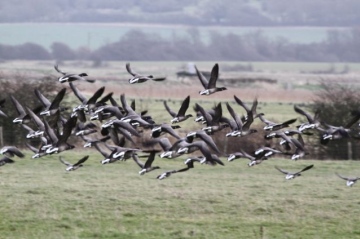 Brent Geese in flight - John Lilley
Brent Geese in flight - John Lilley
Despite the rain it has been a sunnier winter than most and often a joy to be out and about. Even on the dullest January day though birds can provide the life, light, colour and movement that the mind craves at this time of year (or at least this mind does) and there are plenty of those on the farm at the moment – noisy flocks of ground stabbing Rooks and Starlings seeking out leatherjackets, the progeny of last autumn’s bumper crop of Daddy Longlegs; thousands of Peewits, flickering black and white against the blue sky, their crops full of worms forced close to the surface by the constant rain; Curlews plodding methodically across the mudflats, probing deep for lugworms; Brent Geese – their ranks swelled with youngsters after a successful breeding season last year on the Tamyr Peninsular – working their way slowly across the meadows, clipping the grass as short as a garden lawn; and ducks, plenty of ducks. It’s been great weather for ducks!
Vulpes the Fox. He is probably being a little bit ambitious if he has his eye on the Canada Geese behind him - fat and fluffy goslings are more within his range. Thanks again to John for allowing me to use his photo.
Nevertheless, the desire to see things growing again; to plant seedlings in pots and sow seeds in rills; to work in the garden without hands becoming coated in thick cold mud, and to wallow in early spring warmth while watching the wildlife – slugs, snails, greenfly – return to my little plot becomes overwhelming as January drags into February. Spring can’t come soon enough.



















